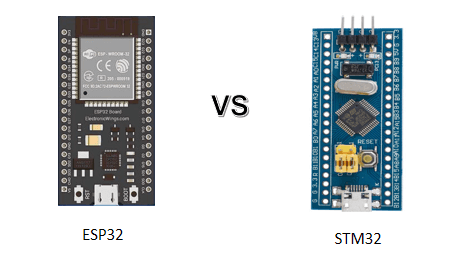
ESP32 vs STM32: Which is Better and How to Choose?
January 24 2025  9
9
Inquiry
Global electronic component supplier AMPHEO PTY LTD: Rich inventory for one-stop shopping. Inquire easily, and receive fast, customized solutions and quotes.
QUICK RFQ
ADD TO RFQ LIST
Choosing between the ESP32 and the STM32 depends on your project's requirements. Both are popular microcontroller families, but they have different strengths that make them better suited for different applications.
Choosing between the ESP32 and the STM32 depends on your project's requirements. Both are popular microcontroller families, but they have different strengths that make them better suited for different applications. Here's a comparison to help you decide which one is best for you:

1. Performance & Processing Power
- ESP32: The ESP32 has a dual-core processor (up to 240 MHz) and offers good performance for its price. It’s a great choice if you need decent computing power for IoT projects.
- STM32: The STM32 family includes a wide range of microcontrollers, from low-end models (Cortex-M0) to high-end ones (Cortex-M7 or M33). The performance depends on the specific model, but in general, STM32 chips can outperform the ESP32 in raw processing power if you're looking at the higher-end models.
2. Connectivity
- ESP32: This is one of its standout features. It comes with built-in Wi-Fi and Bluetooth (classic and BLE). If you need to build wireless communication, especially for IoT projects, the ESP32 is a no-brainer.
- STM32: The STM32 doesn’t have built-in Wi-Fi or Bluetooth on most models. However, it does support external modules and shields, but you would need to add a Wi-Fi/Bluetooth module like the ESP8266 or a Bluetooth module separately, which might take up more space and power.
3. Power Consumption
- ESP32: The ESP32 is relatively power-hungry compared to STM32, especially when using Wi-Fi or Bluetooth. However, it does have power-saving modes, which can be useful for battery-powered projects.
- STM32: Many STM32 models are designed with low power consumption in mind, making them a better choice if you need a low-power device (e.g., in sensor nodes or battery-powered applications).
4. I/O and Peripherals
- ESP32: The ESP32 has a variety of digital I/O pins, ADCs, DACs, and SPI/I2C/UART interfaces. It's a versatile option for handling different types of peripherals.
- STM32: The STM32 series has a wider variety of peripheral options, including advanced timers, more ADC channels, DACs, and even CAN, USB, and Ethernet interfaces, depending on the model. This makes STM32 a better choice for projects requiring more complex peripherals.
5. Development Environment
- ESP32: Development for the ESP32 is often done with Arduino IDE, Espressif's ESP-IDF, or PlatformIO. The environment is generally easier to set up and more beginner-friendly.
- STM32: Development for STM32 is commonly done using STM32CubeIDE, IAR Embedded Workbench, or Keil MDK. It’s slightly more complex than the ESP32 setup, but it offers more advanced features for professional-grade development.
6. Community and Support
- ESP32: The ESP32 has a large, active community and is widely used in IoT and hobbyist projects. There are tons of tutorials, forums, and examples available to help get your project up and running quickly.
- STM32: STM32 also has a large community, especially in professional embedded systems. It’s widely used in industrial, automotive, and consumer electronics applications. While the STM32 community is strong, the resources can be a bit more technical and less beginner-friendly compared to the ESP32.
7. Price
- ESP32: The ESP32 is very affordable and is one of the best choices for projects that require Wi-Fi or Bluetooth without breaking the bank.
- STM32: STM32 microcontrollers are available at a wide range of price points. Entry-level models are quite inexpensive, but some of the high-performance models can be more expensive than the ESP32.
8. Use Cases
- ESP32: Best for IoT projects, smart home applications, wearables, or any project that requires wireless communication (Wi-Fi/Bluetooth).
- STM32: Ideal for projects that require real-time performance, high precision, complex peripherals, and low power consumption. It's common in industrial control systems, robotics, automotive electronics, and audio processing.
When to Choose ESP32:
- You need built-in Wi-Fi or Bluetooth.
- You want a low-cost, high-performance solution for IoT.
- You prefer an easier development environment (like Arduino IDE).
- Your application doesn’t require extensive power-saving features.
When to Choose STM32:
- You need higher-end peripherals (CAN, USB, Ethernet, advanced timers, etc.).
- You require very low power consumption.
- You need more advanced real-time performance and computing power (depending on the STM32 variant).
- You are working on industrial, automotive, or professional-grade applications.
In summary, if you’re building an IoT device, the ESP32 is often the better choice. If you need more complex control, peripherals, or real-time performance, or if your project demands extremely low power consumption, STM32 might be the way to go.
Populer Posts
PIC18F46K22-E/PT
Microchip Technology
S3F8S19XZZ-QR89
Zilog
PIC18F65J15T-I/PT
Microchip Technology
PK22DN512VLK5
NXP USA Inc.
PIC24FJ128GU405-I/PT
Microchip Technology
LM3S9D81-IBZ80-A2
Texas Instruments
NANO100LE3BN
Nuvoton Technology Corporation
PIC18LF2520-I/SO
Microchip Technology
ST72F324BK6TCS
STMicroelectronics
HD407A4374FTI
Renesas Electronics America Inc
R7F701375EAFP-C#AA2
Renesas Electronics America Inc
EFM8BB52F32I-C-QFN32
Silicon Labs
